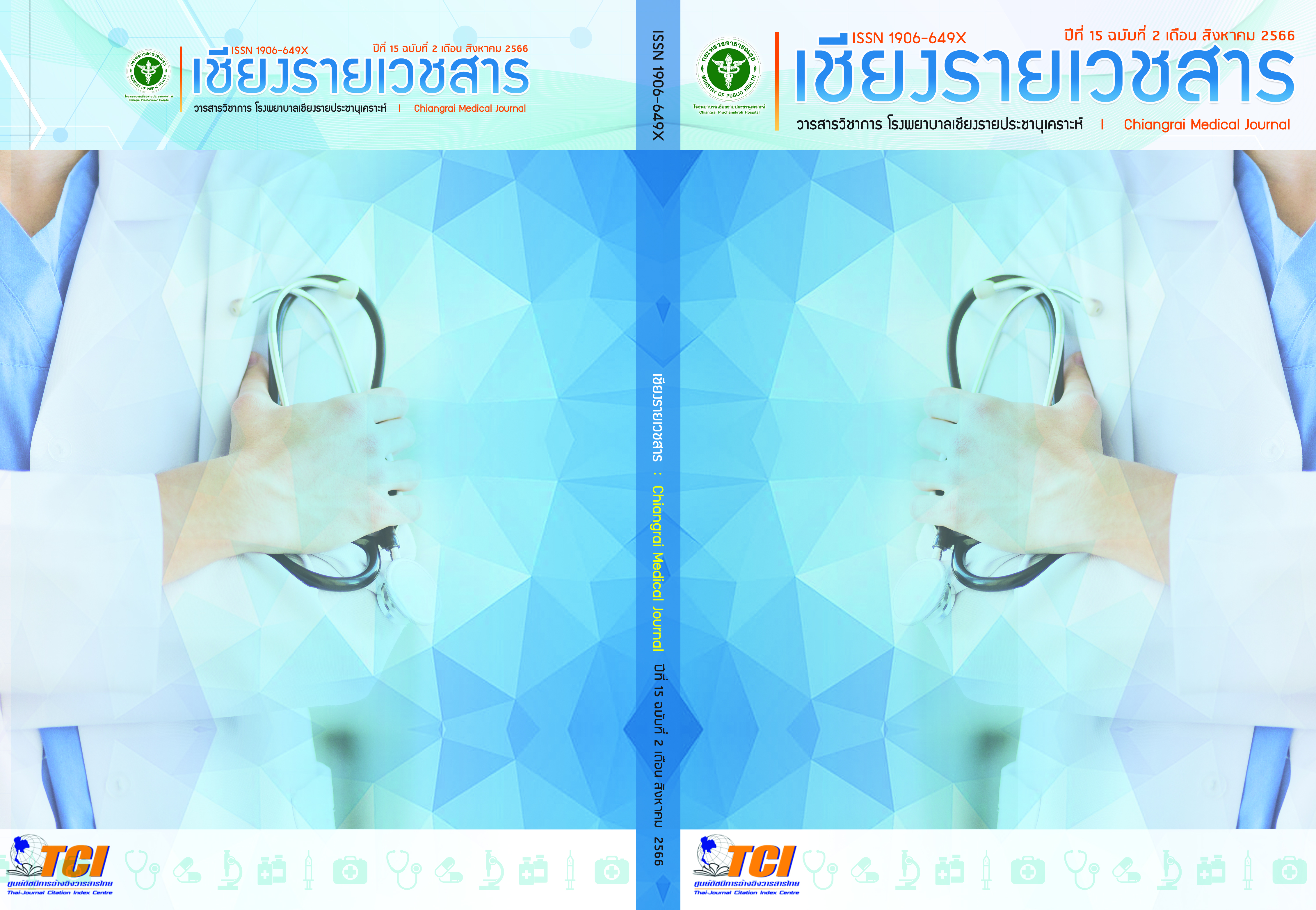ผลของยาสูตรที่สองต่อระยะเวลาการรอดชีวิตและปัจจัยที่มีผลต่อระยะเวลาการรอดชีวิตในผู้ป่วยมะเร็งท่อน้ำดี ระยะแพร่กระจายหลังจากดื้อยาเคมีบำบัดสูตร Cisplatin และ Gemcitabine โรงพยาบาลเชียงรายประชานุเคราะห์
Main Article Content
บทคัดย่อ
ความเป็นมา: ผู้ป่วยมะเร็งท่อน้ำดี ระยะแพร่กระจาย หลังจากดื้อจากยาเคมีบำบัดสูตรแรก ได้แก่ Cisplatin และ Gemcitabine ยังไม่มีการกำหนดการรักษาด้วยยาเคมีบำบัดสูตรสองและขาดข้อมูลผลการรักษา
วัตถุประสงค์: เพื่อศึกษาผลของการให้ยาสูตรที่สองต่อระยะเวลาการรอดชีวิตโดยรวม (overall survival) และปัจจัยที่มีผลต่อระยะเวลาการรอดชีวิตในผู้ป่วยมะเร็งท่อน้ำดี ระยะแพร่กระจาย หลังจากดื้อจากยาเคมีบำบัดสูตร Cisplatin และ Gemcitabine
วิธีการศึกษา: การศึกษาแบบ retrospective cohort study เก็บรวบรวมข้อมูลย้อนหลังของผู้ป่วยมะเร็งท่อน้ำดี ระยะแพร่กระจาย ซึ่งดื้อต่อการรักษาด้วยยาสูตร Cisplatin และ Gemcitabine ในโรงพยาบาลเชียงรายประชานุเคราะห์ ระหว่างปี พ.ศ. 2557 ถึง 2561 โดยวิเคราะห์ระยะเวลาการรอดชีวิต โดยใช้วิธี Kaplan-Meier และ log-rank test ปัจจัยที่ส่งผลต่อระยะเวลาการรอดชีวิต วิเคราะห์ทั้งแบบตัวแปรเดี่ยวและพหุตัวแปรด้วย Cox’s regression
ผลการศึกษา: ผู้ป่วย 143 คน อายุเฉลี่ย 59± 8.14 ปี เป็นเพศชายเฉลี่ย ร้อยละ 57.30 ส่วนใหญ่เป็นชนิด intrahepatic (ร้อยละ 65.70) ในผู้ป่วยกลุ่มที่ได้รับยาเคมีบำบัดสูตรสอง มีระยะเวลารอดชีวิต (median overall survival) 6.20 เดือน เมื่อเทียบกับกลุ่มที่ไม่ได้รับยาเคมีบำบัดสูตรสอง 2.25 เดือน โดยมี hazard ratio 0.25 [95%CI 0.17 - 0.37] และมีนัยสำคัญทางสถิติ ปัจจัยที่มีผลต่อระยะเวลารอดชีวิตอย่างมีนัยสำคัญทางสถิติเมื่อวิเคราะห์แบบพหุตัวแปร ได้แก่ ประวัติเคยได้รับการผ่าตัด ประวัติการควบคุมโรคได้ด้วยยาสูตรแรก ผลตรวจทางห้องปฏิบัติการได้แก่ WBC ≥ 10,000 cell/mm3, NLR ≥ 4 และ Total bilirubin ≥ 3 g/dL และการได้รับยาเคมีบำบัดสูตรสอง โดยเฉพาะการได้รับสูตรยาแบบร่วม
สรุปและข้อเสนอแนะ: ผู้ป่วยมะเร็งท่อน้ำดีระยะแพร่กระจาย ซึ่งดื้อต่อการรักษาด้วยยาสูตร Cisplatin และ Gemcitabine ได้รับประโยชน์จากการได้รับยาเคมีบำบัดสูตรสองจากระยะเวลารอดชีพที่เพิ่มขึ้นอย่างมีนัยสำคัญทางสถิติ อาจใช้เป็นข้อมูลในการกำหนดเป็นแนวทางการรักษาของประเทศไทย
Article Details

อนุญาตภายใต้เงื่อนไข Creative Commons Attribution-NonCommercial-NoDerivatives 4.0 International License.
เอกสารอ้างอิง
Valle J, Wasan H, Palmer DH, Cunningham D, Anthoney A, Maraveyas A, et al. Cisplatin plus gemcitabine versus gemcitabine for biliary tract cancer. N Engl J Med. 2010;362(14):1273-81.
Kobayashi S, Ueno M, Sugimori K, Morizane C, Kojima Y, Irie K, et al. Phase II study of fixed dose-rate gemcitabine plus S-1 as a second-line treatment for advanced biliary tract cancer. Cancer Chemother Pharmacol. 2017;80(6):1189-96.
Cereda S, Milella M, Cordio S, Leone F, Aprile G, Galiano A, et al. Capecitabine with/without mitomycin C: results of a randomized phase II trial of second-line therapy in advanced biliary tract adenocarcinoma. Cancer Chemother Pharmacol. 2016;77(1):109-14.
He S, Shen J, Sun X, Liu L, Dong J. A phase II FOLFOX-4 regimen as second-line treatment in advanced biliary tract cancer refractory to gemcitabine/cisplatin. J Chemother. 2014;26(4):243-7.
Brieau B, Dahan L, De Rycke Y, Boussaha T, Vasseur P, Tougeron D, et al. Second-line chemotherapy for advanced biliary tract cancer after failure of the gemcitabine-platinum combination: A large multicenter study by the Association des Gastro-Enterologues Oncologues. Cancer. 2015;121(18):3290-7.
Lamarca A, Hubner RA, David Ryder W, Valle JW. Second-line chemotherapy in advanced biliary cancer: a systematic review. Ann Oncol. 2014;25(12):2328-38.
Yu T-h, Chen X, Zhang X-h, Zhang E-c, Sun C-x. Clinicopathological characteristics and prognostic factors for intrahepatic cholangiocarcinoma: a population-based study. Scientific Reports. 2021;11(1):3990.
McNamara MG, Templeton AJ, Maganti M, Walter T, Horgan AM, McKeever L, et al. Neutrophil/lymphocyte ratio as a prognostic factor in biliary tract cancer. Eur J Cancer. 2014;50(9):1581-9.
Lamarca A, Palmer DH, Wasan HS, Ross PJ, Ma YT, Arora A, et al. Second-line FOLFOX chemotherapy versus active symptom control for advanced biliary tract cancer (ABC-06): a phase 3, open-label, randomised, controlled trial. The Lancet Oncology. 2021;22(5):690-701.
Sookprasert A, Cheewasathianchai P, Wirasorn K, Sanlung T, Watcharenwong P, Chindaprasirt J. Outcomes of FOLFOX4 chemotherapy as a second-line treatment for advanced biliary tract cancer. J Med Assoc Thai 2021;104(10):14-8.
Thanasombunsukh K, Khorana J, Tantraworasin A, Charoentum C. MO23-3 Benefit of second-line chemotherapy in patients with advanced biliary tract cancer: a propensity score analysis. Annals of Oncology. 2022;33 Suppl 6:S496.
Tan DW, Fu Y, Su Q, Guan MJ, Kong P, Wang SQ, et al. Prognostic significance of neutrophil to lymphocyte ratio in oncologic outcomes of cholangiocarcinoma: a meta-analysis. Sci Rep. 2016;6(1):33789.
Grenader T, Nash S, Plotkin Y, Furuse J, Mizuno N, Okusaka T, et al. Derived neutrophil-lymphocyte ratio may predict benefit from cisplatin in the advanced biliary cancer: the ABC-02 and BT-22 studies. Annals of Oncology. 2015;26(9):1910-6.
Jakubowski CD, Azad NS. Immune checkpoint inhibitor therapy in biliary tract cancer (cholangiocarcinoma). Chinese Clinical Oncology. 2020;9(1):2.
Wu C-E, Chou W-C, Hsieh C-H, Chang JW-C, Lin C-Y, Yeh C-N, et al. Prognostic and predictive factors for Taiwanese patients with advanced biliary tract cancer undergoing frontline chemotherapy with gemcitabine and cisplatin: a real-world experience. BMC Cancer. 2020;20(1):422.
Farhat MH, Shamseddine AI, Tawil AN, et al. Prognostic factors in patients with advanced cholangiocarcinoma: role of surgery, chemotherapy and body mass index. World J Gastroenterol. 2008;14(20):3224-32.
Vogel A, Bridgewater J, Edeline J, et al.Biliary tract cancer: ESMO Clinical Practice Guideline for diagnosis, treatment and follow-up. Ann Oncol. 2022; 34: 127-140.


